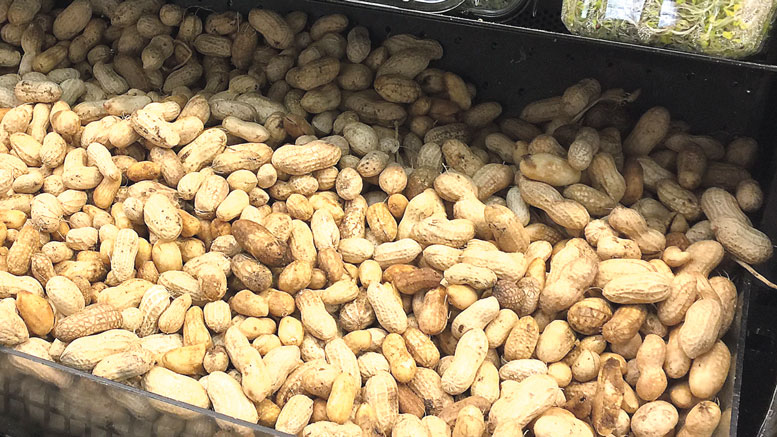Peanuts: Affordable Nutrition for Inflationary Times
February 21, 2023 | 5 min to read
Despite allergen concerns, the consumption of peanuts has risen due to innovative flavors and affordability. As Robbie Koons from Hormel notes, peanuts provide significant value, especially in inflationary times. Companies like Aurora Products and Hampton Farms have introduced exciting varieties, such as Cajun and toffee roasted peanuts, to appeal to consumers. Although school bans challenge the market, the enduring popularity of peanuts reflects their comforting and nutritious appeal, driving demand from farms to retail displays.

Despite allergen concerns, consumption is up thanks to flavor and innovation.
Originally printed in the January 2023 issue of Produce Business.
In these inflationary times, the humble peanut offers consumers a tasty, yet substantial, refuge from the sticker shock that plagues the grocery store.
Suppliers have bolstered the category by introducing new and interesting flavors of peanuts, which gained favor during the pandemic as a familiar, nutritious food.
“Peanuts have, are and will continue to be a tremendous value to consumers when you consider the taste, protein and essential vitamins and nutrients they provide for the price,” says Robbie Koons, Planters brand manager for Hormel Food Corporation, Austin, MN. “In times of inflation when consumers look to drive more value for their dollar, peanuts are a great place to go for a snack with substance.”
Nuts in general have held the line on cost better than most animal sources of protein.
“Many domestic nuts have not gone up in price, although in reality peanuts are a legume, yet referred to as a nut,” says Stephanie Blackwell, CEO of Aurora Products, Orange, CT.
“There has been some impact from inflation, particularly on the peanut butter side, and peanuts have followed suit. But it still remains an affordable product despite some pressures on the crop and the market,” says Ben Fueston, director of supermarket sales, Hampton Farms, Raleigh, NC.
FOCUS ON NATURAL
Blackwell started Aurora Products a quarter century ago in a small warehouse space financed by personal credit cards after deciding there was a need for organic and natural nut, dried fruit, and granola products.
Today, the company offers a variety of flavors with no preservatives or artificial flavors, including Australian ginger, salted sesame sticks, cranberry vanilla crunch granola, organic Thompson raisins, organic prunes, and organic whole cashews.
Peanut producers have gone the extra mile to maintain market share as health concerns deprive them of access to what was once a major market.
“Since peanuts are an allergen, most schools do not allow trail mixes or spreads made out of peanuts to be brought into schools,” Blackwell says. “You see the typical peanut butter being transitioned to almond butter, cashew butter or some other nut butter. This makes it more difficult to grow the category.”
Innovation has provided the solution to keep peanuts near the top.
“New flavors are always being added,” Blackwell says. “We offer Cajun peanuts, toffee roasted peanuts, Tuscan peanuts, etc. We also offer organic peanuts that are flavored.”
Others in the peanut business also try to stay ahead by offering new and different products.
“We try to offer new products as often as we can,” says Koons. “As consumers start to demand more flavors and varieties, we need to be there with products to meet their needs.
“We are seeing a lot of new flavors this year, as we focus on reintroducing incremental items,” says Fueston of Hampton Farms.
GROWTH DESPITE CHALLENGES
Innovation looks to be working, because despite bans from most preschools and many elementary schools, and emerging competition from almond butter, peanut consumption is on the rise.
“Consumers seek out foods that bring them comfort, convenience and good nutrition,” says Bob Parker, president and chief executive of the National Peanut Board, Atlanta, GA. “Americans have a unique love and positive relationship with peanut butter and peanuts, and we’re seeing that demonstrated not only in consumption numbers, but also in the volume and intensity of positive conversations on social and traditional media.”
Peanut popularity is enjoyed down the supply chain to the farms that produce the nuts manufacturers turn into deliciously flavored special delicacies.
“We produce raw, in-the-shell peanuts,” says Gregory Dyer, director of sales and marketing at Sandy Land Peanut Co., Harrellsville, NC. “Demand is good. Every year we add acreage and product.”
SHOW THEM AND THEY WILL BUY
At the retail level, nothing drives peanut sales like displays that draw attention to the product and to its many qualities.
“Packaging and product updates absolutely matter, and it can be looked at from several different angles,” Koons says. “To start, we want our packaging to communicate to consumers all the great things peanuts have to offer inclusive of their cravability and product attributes. We will update our product appropriately when consumers demand it.”
The changing packaging delivers a message to consumers.
“With peanuts often not on the grocery list, it behooves us and the retailer to present merchandising year-round to entice consumers,” says Hampton Farms’ Fueston. He points to football and baseball season as being particularly important to draw consumers to the category. “Being in the produce department can be a big factor.”
Peanut suppliers often ship their products in cases suitable for display on the produce department floor.
“Display-ready cases or shippers work,” says Blackwell.
While most of in-shell peanuts are sold to peanut butter, snack or candy makers, some are sold in-shell the old-fashioned way in produce departments.
“For us, making sure that our in-store display activations align with our customer’s goals as well as our own is the best way to go about it,” Koons says.
“The produce department is a great home for peanuts. We have to make sure that we make it easy for consumers to find a display,” says Fueston.
2 of 8 article in Produce Business February 2023

